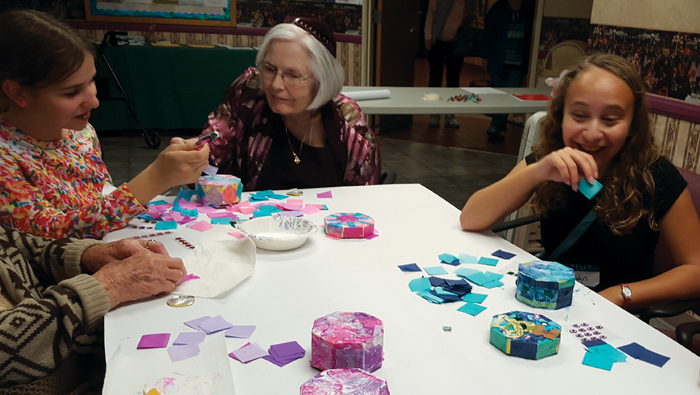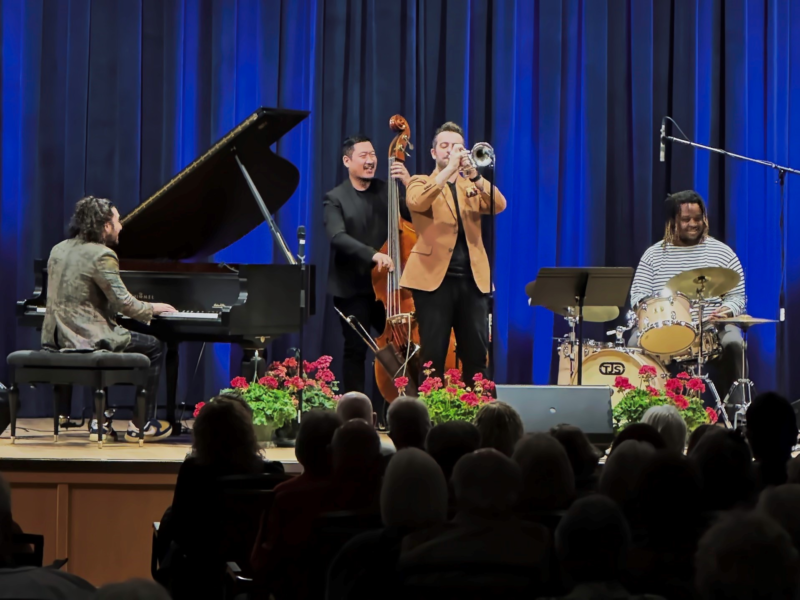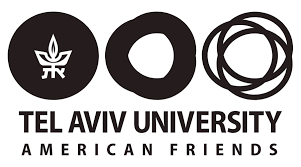One Sunday night a month during the school year, 15 middle school students from across the Valley set aside homework, family, friends and social media to bring joy to the residents of The Palazzo (formerly Brookdale Christown) senior center, where they focused on a different kind of screen time.
It was a monthly highlight for both the seniors and the students, through Better Together Phoenix. This intergenerational initiative is under the auspices of NFTY – the Reform Jewish Youth Movement, although the participants represent all denominations, as well as unaffiliated youth.
“It’s been just fabulous from the standpoint of the kids and the seniors.” says Tami Simmons, program director for Better Together. Tami is the program manager for Jewish Family & Children’s Service Center for Senior Enrichment at The Palazzo, and as a former middle school teacher, she has the ideal skill set to bring the two generations together.
Pat Bruner, 75, a retired cantorial soloist who lives at The Palazzo, agrees that it’s a wonderful program. “It’s good for the kids to see older adults, senior citizens, that we’re more than just people with walkers and canes griping about things. We were teenagers too. And it’s good for us to see nice young kids,” says Pat.
At each session, the students gathered first for a lesson “on how to connect with seniors, how to talk with them, how to respect the elderly. All those things we learn – how to put them into action,” Tami says. Then the students would set up the evening activity – which they chose, planned and prepared – and get everything ready for the seniors.
“The kids came up with ideas of things they wanted to do with us. It was interesting to watch the relationships as they worked one-on-one with seniors,” says Pat.
The student-led activities included cupcake wars, bingo, decorating keepsake boxes, a chocolate seder and speed interviews (students had two minutes to interview each senior as they rotated around the room). About 30-40 seniors attended the monthly events.
“They grew comfortable with the kids, so they looked forward to anything we hosted. It didn’t matter what we were doing. They just wanted to see the kids,” says Tami. And that was part of the goal behind the activities – to get everyone feeling comfortable enough to create a film together, documenting the seniors’ life stories.
Many of the residents who participated don’t have family visiting them frequently, so they truly appreciated their time with the students.
“My kids don’t get to come much because they work all the time,” says JoAnn True, 79. “I’ve been involved in everything the children [in Better Together] have done, from day one. They’re just wonderful kids,” says JoAnn True, 79. “People complain about children today, but these kids are so polite, so respectful. They’re just amazing children. … We want them back all the time.”
To illustrate the impact that the students have, Tami says there’s one resident who has dementia and doesn’t remember anything, but as soon as she sees one of the students, she recognizes her and calls her by name.
Nate Polk, a 7th grader at Temple Chai religious school, says, “It was nice because the seniors had the option to come and enjoy the activities that we hosted at the same time they got to bond with us. … Everybody seemed to know how much they were affecting the lives of these seniors.”
Paul Lopez, a film student at the University of Advanced Technology, worked with the students on the film, teaching them everything from lighting to editing. Every student was assigned a task on the film, so they all had a sense of ownership.
“I tell the kids, ‘You have the last opportunity to get memories and stories from these seniors. You’re going to interview them and put them on film, so that the next generation after you can hear their stories and their memories and their experiences.’ And they understand how important it is to really talk to them and learn from them,” Tami says.
During the final session, Faith Rosky, a 7th grader at Sonoran Trails Middle School and Chabad Hebrew School, interviewed 12 seniors with cameras rolling for the film. She asked questions prepared by a team of students about where they were born, their lives as teenagers, their first jobs, what they think of today’s younger generation, their pets and children, if they’re married or widowed and more.
“It was so much fun. It was one of the most amazing experiences,” says Faith. “There were so many interesting questions, but I think the one that really stuck out to me was, ‘What do you think of the new generation?’ because there’s a lot of mixed feelings about it. Some people think we’re geniuses with all this new technology and innovations and ideas. And then others think well, the technology is great, but there’s almost too much technology and nobody spends time with anybody anymore or socializes. And it’s interesting to see how that varies.
“I have a phone, and one of the things that a lot of the seniors mentioned was, ‘Oh my gosh. They’re on their phones too much.’ So it kind of wakes me up and brings awareness … to how important it is to still be able to talk, whether with seniors, or your friends or just people in general. So they helped me,” Faith reflects.
Nate, who helped edit the film, notes comparisons between his childhood and the seniors who were interviewed. “I got to learn about how life was in the 1900s. It was memorable about how little influence technology had in the world at that point and how communication was a lot harder across far distances. But you seemed to be with your friends and be outside a lot more than you are now,” he says.
The program culminated with a screening of the student film for the seniors, students, their families on May 1.
For Faith, the most rewarding part of the program has been the reaction of the seniors. “It’s going in and getting everything set up and then seeing this huge grin totally spread across their faces. You look at them and they look at you. Afterward, when you start cleaning up, they come up to you and they shake your hand, and they look you in the eye and they say, ‘Thank you so much for doing this – it means the world.’ Those words – ‘it means the world’ – that also means the world to me.”






